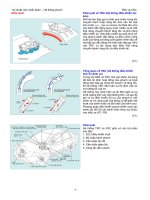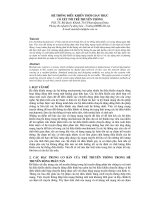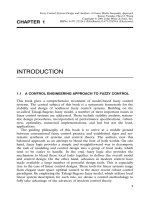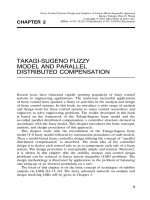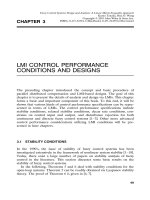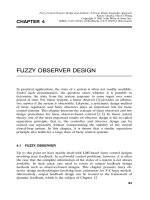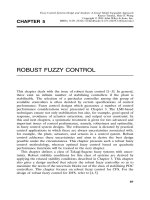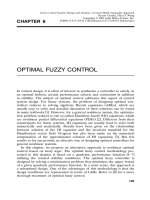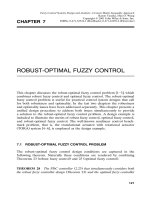Tài liệu Hệ thống điều khiển mờ - Thiết kế và phân tích P1 pdf
Bạn đang xem bản rút gọn của tài liệu. Xem và tải ngay bản đầy đủ của tài liệu tại đây (62.9 KB, 3 trang )
Fuzzy Control Systems Design and Analysis: A Linear Matrix Inequality Approach
Kazuo Tanaka, Hua O. Wang
Copyright ᮊ 2001 John Wiley & Sons, Inc.
Ž. Ž .
ISBNs: 0-471-32324-1 Hardback ; 0-471-22459-6 Electronic
CHAPTER 1
INTRODUCTION
1.1 A CONTROL ENGINEERING APPROACH TO FUZZY CONTROL
This book gives a comprehensive treatment of model-based fuzzy control
systems. The central subject of this book is a systematic framework for the
stability and design of nonlinear fuzzy control systems. Building on the
so-called Takagi-Sugeno fuzzy model, a number of most important issues in
fuzzy control systems are addressed. These include stability analysis, system-
atic design procedures, incorporation of performance specifications, robust-
ness, optimality, numerical implementations, and last but not the least,
applications.
The guiding philosophy of this book is to arrive at a middle ground
between conventional fuzzy control practice and established rigor and sys-
tematic synthesis of systems and control theory. The authors view this
balanced approach as an attempt to blend the best of both worlds. On one
hand, fuzzy logic provides a simple and straightforward way to decompose
the task of modeling and control design into a group of local tasks, which
tend to be easier to handle. In the end, fuzzy logic also provides the
mechanism to blend these local tasks together to deliver the overall model
and control design. On the other hand, advances in modern control have
made available a large number of powerful design tools. This is especially
true in the case of linear control designs. These tools for linear systems range
from elegant state space optimal control to the more recent robust control
paradigms. By employing the Takagi-Sugeno fuzzy model, which utilizes local
linear system description for each rule, we devise a control methodology to
fully take advantage of the advances of modern control theory.
1
INTRODUCTION
2
We have witnessed rapidly growing interest in fuzzy control in recent
years. This is largely sparked by the numerous successful applications fuzzy
control has enjoyed. Despite the visible success, it has been made aware that
many basic issues remain to be addressed. Among them, stability analysis,
systematic design, and performance analysis, to name a few, are crucial to the
validity and applicability of any control design methodology. This book is
intended to address these issues in the framework of the Takagi-Sugeno
fuzzy model and a controller structure devised in accordance with the fuzzy
model.
1.2 OUTLINE OF THIS BOOK
This book is intended to be used either as a textbook or as a reference for
control researchers and engineers. For the first objective, the book can be
used as a graduate textbook or upper level undergraduate textbook. It is
particularly rewarding that using the approaches presented in this book, a
student just entering the field of control can solve a large class of problems
that would normally require rather advanced training at the graduate level.
This book is organized into 15 chapters. Figure 1.1 shows the relation
among chapters in this book. For example, Chapters 1᎐3 provide the basis
for Chapters 4᎐5. Chapters 1᎐3, 9, and 10 are necessary prerequisites to
Fig. 1.1 Relation among chapters.
OUTLINE OF THIS BOOK
3
understand Chapter 11. Beyond Chapter 3, all chapters, with the exception of
Chapters 7, 11, and 13, are designed to be basically independent of each
other, to give the reader flexibility in progressing through the materials of
this book. Chapters 1᎐3 contain the fundamental materials for later chapters.
The level of mathematical sophistication and prior knowledge in control have
been kept in an elementary context. This part is suitable as a starting point in
a graduate-level course. Chapters 4᎐15 cover advanced analysis and design
topics which may require a higher level of mathematical sophistication and
advanced knowledge of control engineering. This part provides a wide range
of advanced topics for a graduate-level course and more importantly some
timely and powerful analysis and design techniques for researchers and
engineers in systems and controls.
Each chapter from 1 to 15 ends with a section of references which contain
the most relevant literature for the specific topic of each chapter. To probe
further into each topic, the readers are encouraged to consult with the listed
references.
In this book, S ) 0 means that S is a positive definite matrix, S ) T
means that S y T ) 0 and W s 0 means that W is a zero matrix, that is, its
elements are all zero.
To lighten the notation, this book employs several particular notions which
are listed as follow:
i - j s.t. h l h /
,
ij
i F j s.t. h l h /
.
ij
Ž.
For instance, the condition 2.31 in Chapter 2 has the notation,
i - j F r s.t. h l h /
.
ij
This means that the condition should be hold for all i - j excepting h l h
ij
w Ž Ž .. Ž Ž .. Ž ..x ŽŽ..
s
i.e., h z t = h z t s 0 for all z t , where h z t denotes the
ij i
weight of the ith rule calculated from membership functions in the premise
parts and r denotes the number of if-then rules. Note that h l h s
if
ij
and only if the ith rule and jth rule have no overlap.
